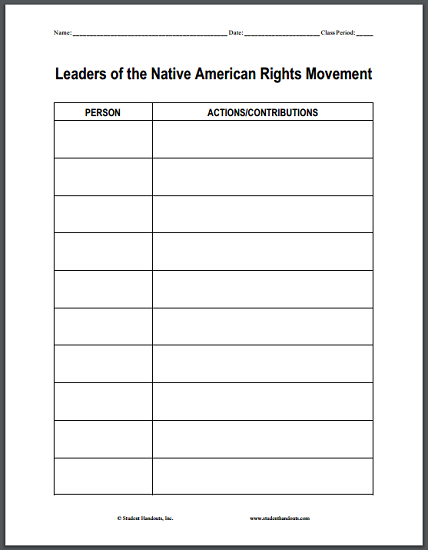| Leaders of the Movement for Native-American Rights |
|---|
| www.studenthandouts.com ↣ U.S. History ↣ Decades of Change ↣ Worksheets |
 |
    |
|
Students are asked to list leaders of the movement for Native-American rights, and describe each person's contributions. Click here to print (PDF file). Answers will vary. The movement for Native American rights has seen numerous leaders who have made significant contributions to advancing the cause of sovereignty, cultural preservation, and justice. Wilma Mankiller: The first female Principal Chief of the Cherokee Nation, Mankiller led initiatives to improve healthcare, education, and housing for her people. She emphasized community development and self-governance, becoming a symbol of Native American women's leadership. Dennis Banks: A co-founder of the American Indian Movement (AIM), Banks played a crucial role in organizing protests and occupations, such as the occupation of Alcatraz Island and the Wounded Knee standoff. He advocated for Native American rights, sovereignty, and cultural preservation. Russell Means: Another prominent AIM leader, Means was instrumental in the Trail of Broken Treaties and the Wounded Knee occupation. He was a vocal advocate for Native American rights and used his platform to raise awareness about the injustices faced by Native communities. Vine Deloria Jr.: A scholar, activist, and author of Custer Died for Your Sins, Deloria was influential in articulating the struggles and aspirations of Native Americans. His work emphasized the importance of sovereignty, self-determination, and the preservation of Native cultures and traditions. Leonard Peltier: A member of AIM, Peltier was involved in the 1975 shootout at Pine Ridge Reservation, which led to his controversial conviction and imprisonment. He has become a symbol of the fight against injustice and the call for fair treatment of Native Americans in the legal system. LaDonna Harris: A comanche political activist, Harris founded Americans for Indian Opportunity (AIO) and worked to promote Native American rights and self-determination. She has been involved in various legislative efforts to support Native American communities and has been a mentor to young Native leaders. Winona LaDuke: An environmental activist and economist, LaDuke focuses on sustainable development and environmental justice for Native communities. She co-founded Honor the Earth, which supports environmental protection and indigenous rights, and has been a strong voice against resource exploitation on Native lands. John Trudell: An AIM spokesperson and poet, Trudell was a prominent figure during the Alcatraz occupation and other AIM activities. He used his artistic talents to raise awareness about Native American issues and advocate for justice and sovereignty. Ada Deer: A member of the Menominee Tribe, Deer was instrumental in the Menominee Restoration Act of 1973, which reversed the termination of the Menominee Tribe and restored federal recognition. She later became the first Native American woman to head the Bureau of Indian Affairs. Clyde Bellecourt: Another co-founder of AIM, Bellecourt played a key role in organizing major protests and advocacy efforts for Native American rights. He was deeply involved in education reform and the fight for treaty rights and sovereignty. These leaders, through their activism, leadership, and advocacy, have significantly advanced the movement for Native American rights, contributing to greater awareness, legal reforms, and the ongoing struggle for justice and equality. |
| www.studenthandouts.com ↣ U.S. History ↣ Decades of Change ↣ Worksheets |








